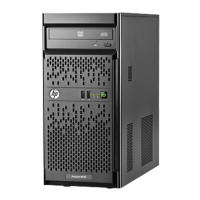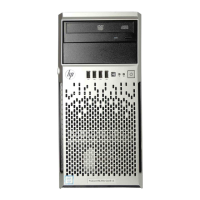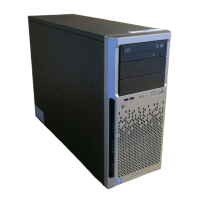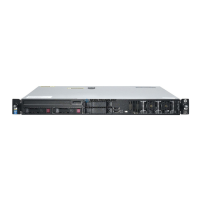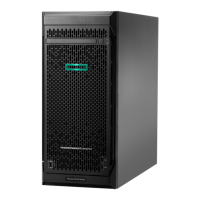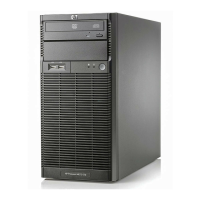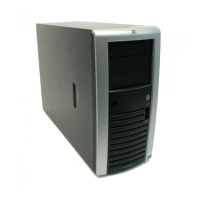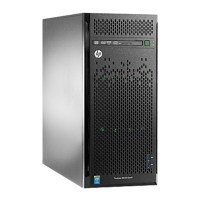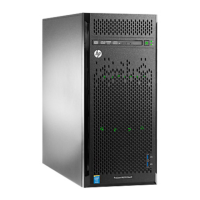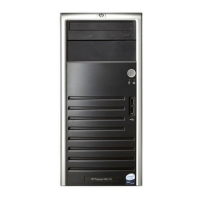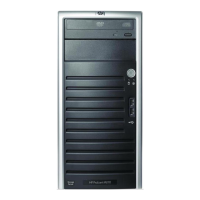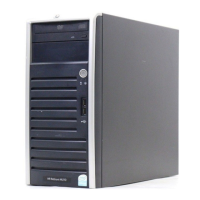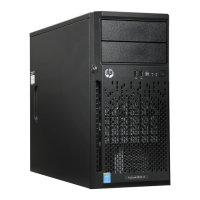

Do you have a question about the HP ProLiant ML10 v2 and is the answer not in the manual?
| Bus type | DMI |
|---|---|
| Stepping | C0 |
| FSB Parity | No |
| Scalability | 1S |
| Processor cache | 8 MB |
| Processor cores | 4 |
| Processor model | E3-1220V3 |
| System bus rate | 5 GT/s |
| Processor series | Intel Xeon E3-1200 v3 |
| Processor socket | LGA 1150 (Socket H3) |
| Processor codename | Haswell |
| Motherboard chipset | Intel® C222 |
| Processor frequency | 3.1 GHz |
| Processor cache type | Smart Cache |
| Processor lithography | 22 nm |
| Processor manufacturer | Intel |
| Processor package size | 37.5 x 37.5 mm |
| Processor front side bus | - MHz |
| Processor boost frequency | 3.5 GHz |
| Processor operating modes | 64-bit |
| ECC supported by processor | Yes |
| PCI Express configurations | 1x8, 1x16, 2x4, 2x8 |
| Supported instruction sets | AVX 2.0, SSE4.1, SSE4.2 |
| Thermal Design Power (TDP) | 80 W |
| Compatible processor series | Intel® Xeon® |
| Number of processors installed | 1 |
| Thermal solution specification | PCG 2013D |
| Maximum number of PCI Express lanes | 16 |
| Memory types supported by processor | DDR3-SDRAM |
| Memory channels supported by processor | Dual |
| Memory clock speeds supported by processor | 1333, 1600 MHz |
| Memory bandwidth supported by processor (max) | 25.6 GB/s |
| Maximum internal memory supported by processor | 32 GB |
| HDD size | 3.5 \ |
| HDD interface | - |
| SSD interface | Serial Attached SCSI (SAS) |
| Total storage capacity | 1000 GB |
| Maximum storage capacity | 24 TB |
| Memory slots | 4x DIMM |
| Internal memory | 8 GB |
| Memory clock speed | 1600 MHz |
| Graphics card | G200 |
| DVD interface type | SATA |
| Graphics card family | Matrox |
| Intel® Virtualization Technology (Intel® VT) | VT-d, VT-x |
| Cabling technology | 10/100/1000Base-T(X) |
| Ethernet interface type | Gigabit Ethernet |
| Serial ports quantity | 0 |
| USB 2.0 ports quantity | 2 |
| PCI Express slots version | 3.0 |
| Performance management | HP iLO |
| Compatible operating systems | Microsoft Windows Server\\r Canonical Ubuntu\\r Red Hat Enterprise Linux (RHEL)\\r SUSE Linux Enterprise Server (SLES)\\r VMware |
| Processor ARK ID | 75052 |
| Intel Identity Protection Technology version | 1.00 |
| Chassis type | Tower (4U) |
| Power supply | 350 W |
| Operating altitude | 0 - 3048 m |
| Non-operating altitude | 0 - 9144 m |
| Storage temperature (T-T) | -30 - 65 °C |
| Operating temperature (T-T) | 0 - 40 °C |
| Storage relative humidity (H-H) | 0 - 95 % |
| Operating relative humidity (H-H) | 10 - 90 % |
| On-board graphics card model | Not available |
| Depth | 475.2 mm |
|---|---|
| Width | 175 mm |
| Height | 368.2 mm |
Identifies and describes the components located on the front panel of the server.
Details the status indicators (LEDs) and operational buttons on the front panel.
Explains the meaning of front panel LED behaviors indicating power faults.
Identifies and describes the components located on the rear panel of the server.
Details the status indicators (LEDs) and connectors on the rear panel.
Identifies key components and connectors on the server's system board.
Illustrates the physical locations, numbering, and channel assignments of DIMM slots.
Provides technical specifications for the various PCIe expansion slots.
Explains the function and configuration of the system maintenance switch.
Describes the Non-Maskable Interrupt feature for crash dump generation.
Illustrates the numbering sequence for internal drive bays.
Step-by-step instructions for powering on the server.
Procedures for safely shutting down and powering off the server.
Guide on how to install the server's front tower bezel.
Instructions on how to unlock and open the server's front bezel.
Steps for detaching and removing the server's front tower bezel.
Guide for fitting and securing the server's side access panel.
Steps for detaching and removing the server's side access panel.
Instructions for installing the internal air baffle for cooling.
Steps for detaching and removing the internal air baffle.
Overview of HP's optional support services for server installation.
Recommendations for the ideal server operating environment.
Specifies clearance needed for proper server ventilation.
Details acceptable operating temperature ranges for the server.
Guidelines for electrical power installation and safety.
Procedures for ensuring proper electrical grounding of the server.
Important safety notices and warnings for server handling and operation.
Lists the items and documentation included in the server package.
General guidance for installing additional hardware components.
Steps for installing a supported operating system on the server.
How to power on the server and access setup utilities.
Instructions for registering the server with HP for support.
General advice for installing multiple hardware options efficiently.
Information on supported drive types and configurations for the server.
Best practices and guidelines for installing server drives.
Detailed step-by-step guide for installing a hard drive.
Information on available storage controller options for the server.
Specific instructions for installing an HP H220/H221 Host Bus Adapter.
Guide for installing an optional optical drive into the server.
Features and benefits of HP SmartMemory technology for servers.
How to identify DIMM characteristics using labels and illustrations.
Explanation of the differences between single-rank and dual-rank DIMMs.
Overview of the server's memory channels, slots, and population order.
Description of Error Correcting Code (ECC) memory functionality.
Rules and best practices for correctly populating DIMM slots.
Detailed step-by-step guide for installing a memory module.
Instructions for configuring and connecting an optional HP network switch.
Information about the Trusted Platform Module (TPM) security hardware option.
Detailed steps for physically installing the TPM hardware.
Importance of saving recovery keys for BitLocker and TPM security.
Procedures to enable and configure the TPM after installation.
General guidelines for optimal server and hardware cabling.
Instructions for connecting internal storage devices.
Specific cabling for SATA drives connected directly to the system board.
Cabling instructions for drives connected via a storage controller.
Instructions for connecting the internal optical drive.
Explains the different operational modes (online/offline) for utilities.
Reference to detailed online product specifications and features.
Introduction to the Integrated Lights-Out management interface.
Description of the Integrated Management Log (IML) for system events.
Details on HP's remote system monitoring and support services.
How to connect directly to HP Insight Online for remote support.
Overview of the HP Insight Online support portal dashboard.
Tool for performing server diagnostics and troubleshooting.
Using HP Insight Diagnostics for gathering system information.
Tool for automating server deployments and configurations.
Information on the Service Pack for ProLiant (SPP) for system updates.
Tool for installing and managing server software and firmware.
Procedure for updating server identification details after system board replacement.
Introduction to various server management utilities and features.
Configuration and management tool for HP storage controllers.
Feature for automatic server restarts after operating system failures.
Information on USB connectivity, versions, and support.
Explanation of the server's redundant ROM feature for reliability.
Guidance on installing and updating device drivers.
Procedures for updating system software and firmware.
Reference for supported operating system versions.
Tools for managing software versions across enterprise systems.
Resource for information on supported operating systems and virtualization software.
Overview of HP's technology services and consulting offerings.
HP's process for notifying customers about upcoming product changes.
Links to guides and resources for resolving server issues.
Detailed step-by-step guide for removing the system battery.
General safety, environmental, and regulatory compliance information.
Specific material content declaration for Turkey.
Specific material content declaration for Ukraine.
Links to warranty details for various HP product categories.
Precautions to avoid damage from static electricity discharge.
Techniques and methods for proper electrical grounding.
Details on server operating temperature and humidity ranges.
Physical dimensions and weight specifications for the server.
Information on the server's integrated power supply unit.
Information to have ready before contacting HP support.
Contact details and methods for reaching HP support.
Program details for customers performing their own part replacements.
Glossary of common technical terms and abbreviations used in the manual.
